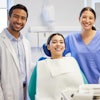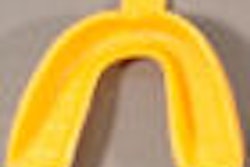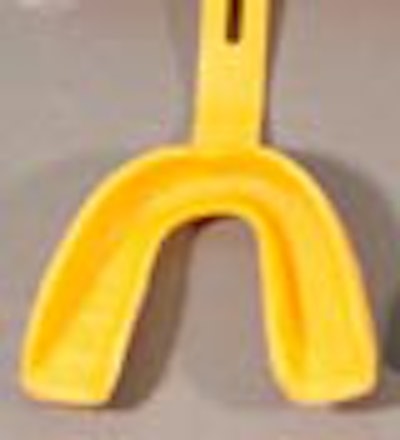
It all started with the kind of bruise athletes usually shrug off. During football practice, a 13-year-old player took a hit in the leg. But instead of healing, the leg kept swelling until it was double the size. Doctors prescribed antibiotics to no avail. The leg kept getting bigger.
Finally only intravenous vancomycin and nafcillin -- two last-resort drugs used against antibiotic-resistant bacteria -- brought the swelling down. But doctors remained puzzled about the source of the infection until researchers at Oklahoma State University (OSU) pinned it on a surprising source: the mouthguard that the patient had been wearing during football practice.
Mouthguards, the researchers write in the September/October General Dentistry, harbor virulent microbes. With wear and tear, mouthguards develop jagged edges that can cut the athlete's mouth, creating an entryway for these pathogens. The patient had oral sores attributed to the mouthguard, and the researchers theorize Stomatococcusmucilaginosus flowed through these wounds into his bloodstream, eventually traveling to the leg because of the inflammation following the initial injury. "We found the same organism in the mouthguard and in the pus from his leg," said R. Thomas Glass, D.D.S., Ph.D., a professor of forensic sciences, pathology and dental medicine at OSU's College of Osteopathic Medicine.
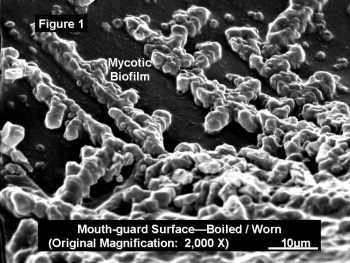 |
| Microscopic image of biofilm on a used mouthguard. Image courtesy of R. Thomas Glass, D.D.S., Ph.D. |
This infection was no fluke, Dr. Glass said. He's convinced that many other people are getting sick from bacteria, viruses, and mold living on their mouthguards. In the same article, he and his co-authors describe another football player who suffered from asthma only while wearing his mouthguard. When he played basketball, he could breathe just fine. Dr. Glass and his colleagues found five species of mold on the mouthguard. "You can't run down the field breathing in mold and not get the symptoms of asthma," he said.
Mouthguards, however, are required by many sports leagues, especially for football, to prevent damage to the player's mouth. So what advice can a dentist give patients participating in these sports? Dr. Glass has a simple solution: Throw the mouthguards away after each use. Stock mouthguards can be bought for as little as $1.50 each in a drugstore, he noted.
 |
| Mouthguards: Custom-fitted mouthguard (left); "boil-and-bite" mouthguard (center); inexpensive "stock" mouthguard (right). Images courtesy of Ray Padilla, D.D.S. |
Not everyone's ready to go along with that recommendation. "Disposable mouthguards are not protective," said Ray Padilla, D.D.S., a Los Angeles dentist who lectures on sports dentistry at the University of California, Los Angeles. "They don't have proper thickness in critical areas." Boil-and-bite mouthguards, which athletes mold to their teeth at home, are no better, he said. "The only mouthguards I promote are professionally custom made from a model of the patient's mouth."
Most dentists charge $50 to $300 for custom sports mouthguards, and patients sometimes wear them for years. Dr. Padilla believes in them so fervently that he makes them for his patients for free.
What about the infection problem? "There's bacteria on everything," Dr. Padilla said. He recommends that athletes brush their mouthguards with a toothbrush, treat them with Listerine, and brush their teeth before wearing them (though he recognizes that brushing may not be practical for everyone).
There's only one problem, according to Dr. Glass: surface tension. The pores in mouthguards are so small, he said, that no antimicrobial liquid, including Listerine, can get in to roust the germs from their lairs. "We've tested almost everything."
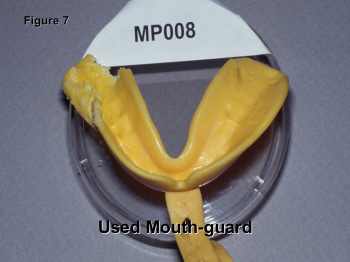 |
| Oklahoma State University researchers believe that jagged edges on used athletic mouthguards like this one can cut the athlete's mouth, allowing microbes to enter. Image courtesy of R. Thomas Glass, D.D.S., Ph.D. |
Dr. Glass questions whether mouthguards make much difference in sports anyway. In football, he reasons, the bars across the players' faces protect their mouths.
All this contrary advice leaves the general dentist with a dilemma. Should you make custom mouthguards for your athletic patients? Recommend the disposable kind? Wash your hands of the whole business?
For now, most dentists are probably taking their lead from the American Dental Association, which is squarely in Dr. Padilla's corner on this issue; the organization recommends custom-fitted mouthguards for any sport in which a player might get hit in the mouth. The Academy for Sports Dentistry agrees.
But stay tuned. Dr. Glass and his colleagues are crunching the numbers from a large study that he believes will clinch his case. We'll let you know what he finds.
Copyright © 2009 DrBicuspid.com


